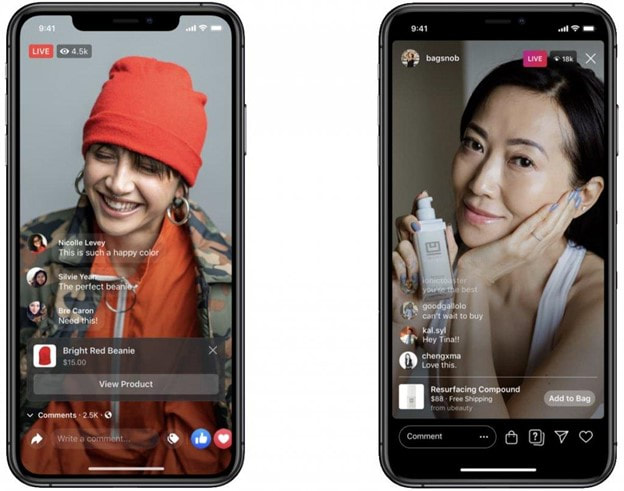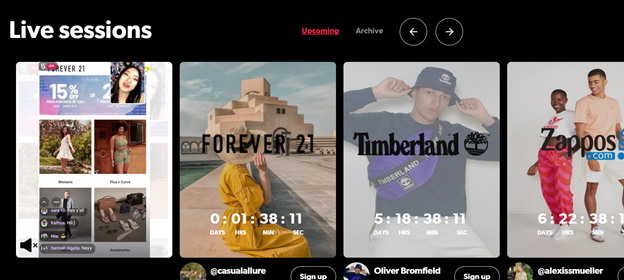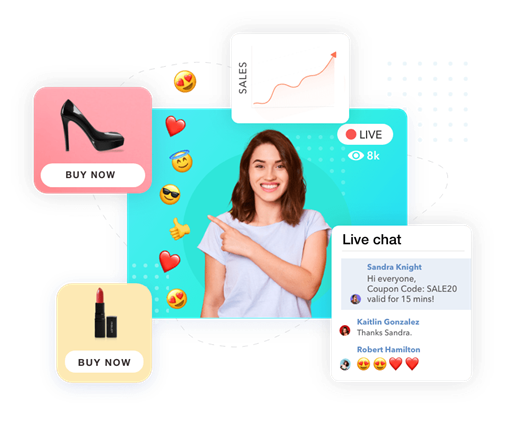Livestream Shopping: the Future of E-commerce
Big brands and small companies thrive in live commerce nowadays. This industry has experienced tremendous growth in the past few years, with estimates going as high as $184.3 billion by 2027. In the world of social media, and especially when it comes to shopping, this is one of the people's most favorite sources of information.
What is Livestream shopping?
Livestream shopping is not such a novelty.
Four decades ago, television shopping networks introduced real-time advertisements where people could use a special offer by calling the phone. Thanks to technology, live shopping took a huge leap and is now available all around us.
This is a huge trend across the globe right now, but it has been here for quite some time. Livestream eCommerce has been trending in China for many years. In 2019, for example, 37% of shoppers in China bought things from live streams. It was months later than the concept was introduced in the US, Europe, and other markets.
It has grown even more significant due to the pandemic.
During the COVID-19 pandemic, over 255 million US people were doing their shopping online. These numbers keep growing and are projected to reach at least 278 million by 2024. Many of those shoppers decide to buy something after watching a live video or a stream.
So, what is livestream shopping?
According to Whisbi, a leader in live engagement today, this has become one of the top eCommerce trends in the modern world. This concept offers a more immersive shopping experience to people. With platforms like Instagram and Facebook that offer live streaming and videos, companies can enjoy wider reach than ever – and prompt their customers to take fast action in making an actual purchase.
What is Livestream shopping?
Livestream shopping is not such a novelty.
Four decades ago, television shopping networks introduced real-time advertisements where people could use a special offer by calling the phone. Thanks to technology, live shopping took a huge leap and is now available all around us.
This is a huge trend across the globe right now, but it has been here for quite some time. Livestream eCommerce has been trending in China for many years. In 2019, for example, 37% of shoppers in China bought things from live streams. It was months later than the concept was introduced in the US, Europe, and other markets.
It has grown even more significant due to the pandemic.
During the COVID-19 pandemic, over 255 million US people were doing their shopping online. These numbers keep growing and are projected to reach at least 278 million by 2024. Many of those shoppers decide to buy something after watching a live video or a stream.
So, what is livestream shopping?
According to Whisbi, a leader in live engagement today, this has become one of the top eCommerce trends in the modern world. This concept offers a more immersive shopping experience to people. With platforms like Instagram and Facebook that offer live streaming and videos, companies can enjoy wider reach than ever – and prompt their customers to take fast action in making an actual purchase.
|
Livestream shopping is used by brands of different sizes and in different industries to sell and promote products through live streams on a variety of digital platforms. They often do this with the assistance of influencers, though we can certainly notice big brands going at it alone, too.
Why is livestream shopping a trend? The interest in this type of shopping is growing every day. Coresight Research reports that this type of eCommerce will reach $25 billion in sales in the US alone by the year 2023. Why is this? |
The e-commerce industry is constantly trying to figure out new ways to attract the attention of consumers. With the invention of social media platforms – as well as their enormous popularity, it's no wonder that the e-commerce business has pushed most of its marketing effort in that direction. Ever since social media platforms introduced live streams, brands captured the opportunity and turned this into a way to make sales – and attract a wider audience.
All this brought on huge adaptations in terms of the marketing strategies and approaches. Most brands nowadays not only use live streaming as a way to boost sales, but they combine this with one of the strongest marketing tools of today – influencers.
Take, for example, Walmart. In December 2020, they joined forces with Tik Tok and created their first-ever livestream shopping event. More than 10 influencers joined this event and started doing virtual try-ons, all whilst answering the viewers' questions. This brought a whole new level of interest and engagement and was a huge success for the brand.
The field is getting more competitive than ever!As the interest in livestream shopping grows, so does the number of new players in this market. This makes it more important than ever to not only grasp the concept but also create something amazing for people to see and respond to.
Some tips for beating the competition in the eCommerce livestream world
There are many live streams nowadays from brands attempting to capture their target audience’s attention. In this competitive industry, only the most informed and creative can succeed in achieving this. If you decide to create a live stream that people will use for shopping, you need to research your target audience first and tackle their pain points. Attest's template for market analysis is a great way to obtain this information and invest in a successful livestream event.
The next step would be to prepare for your stream. This includes preparing your products and services, the people who will appear in the stream, as well as taking care of software and other technology. You will need to pick a good video format, find a quality camera, ensure that your Internet connection is running smoothly, etc.
It takes a lot of work, but if you do it right, this might just be your best move for making sales right now.
Sites and tools that facilitate livestream shopping
This has become so popular that there are actual brands now helping other brands offer livestream shopping.
There’s the NTWRK app which offers various shopping livestreams for limited-availability designer sneakers and streetwear. This is a hub for exclusive brands and NFTs, as well as broadcasters that discuss products available when the show airs. Interested parties can enter their lottery or join an auction for exclusive titles. Soon after it was established NTWRK has become one of the top-rated livestream eCommerce platforms on the market.
Next is BuyWith, a company offering livestream sessions to shoppers thanks to its picture-in-picture feature. It allows viewers and broadcasters to connect and do their shopping on various websites. You can also use it to contact influencers and build collaboration for other advertising purposes while the livestream is being broadcasted.
All this brought on huge adaptations in terms of the marketing strategies and approaches. Most brands nowadays not only use live streaming as a way to boost sales, but they combine this with one of the strongest marketing tools of today – influencers.
Take, for example, Walmart. In December 2020, they joined forces with Tik Tok and created their first-ever livestream shopping event. More than 10 influencers joined this event and started doing virtual try-ons, all whilst answering the viewers' questions. This brought a whole new level of interest and engagement and was a huge success for the brand.
The field is getting more competitive than ever!As the interest in livestream shopping grows, so does the number of new players in this market. This makes it more important than ever to not only grasp the concept but also create something amazing for people to see and respond to.
Some tips for beating the competition in the eCommerce livestream world
There are many live streams nowadays from brands attempting to capture their target audience’s attention. In this competitive industry, only the most informed and creative can succeed in achieving this. If you decide to create a live stream that people will use for shopping, you need to research your target audience first and tackle their pain points. Attest's template for market analysis is a great way to obtain this information and invest in a successful livestream event.
The next step would be to prepare for your stream. This includes preparing your products and services, the people who will appear in the stream, as well as taking care of software and other technology. You will need to pick a good video format, find a quality camera, ensure that your Internet connection is running smoothly, etc.
It takes a lot of work, but if you do it right, this might just be your best move for making sales right now.
Sites and tools that facilitate livestream shopping
This has become so popular that there are actual brands now helping other brands offer livestream shopping.
There’s the NTWRK app which offers various shopping livestreams for limited-availability designer sneakers and streetwear. This is a hub for exclusive brands and NFTs, as well as broadcasters that discuss products available when the show airs. Interested parties can enter their lottery or join an auction for exclusive titles. Soon after it was established NTWRK has become one of the top-rated livestream eCommerce platforms on the market.
Next is BuyWith, a company offering livestream sessions to shoppers thanks to its picture-in-picture feature. It allows viewers and broadcasters to connect and do their shopping on various websites. You can also use it to contact influencers and build collaboration for other advertising purposes while the livestream is being broadcasted.
|
Finally, you have Shoploop, Google’s latest R&D project. This is a video platform that resembles TikTok. Similar to the popular platform, Shoploop also introduces viewers to products in short video livestreams. These last for a maximum of 90 seconds, enticing the viewers to take a fast purchase. Creators can then keep their livestream videos in their profile, and their customers can browse through them when they wish to. They can even choose to take action – save them for later or shop directly in Shoploop.
|
Livestream vs. video in the eCommerce industryFor quite some time, both have existed on the market, so neither is new or unexplored. Videos have been trending for much longer, and live streams are still growing in popularity.
Even so, it seems like livestreams are swiftly gaining popularity, and are now a favored marketing tool among brands. More and more brands today are investing more money and time in creating live streams simply because they get better results with this type of marketing.
The Interactive Advertising Bureau has reported that 47% of live streaming viewers are doing this more often and more frequently compared with only a year ago. Right now, the interest is split between traditional and live stream videos, with a trending rise in the latter. This is partly because it is more of a novelty and partly because it is more inclusive. Either way, we can certainly say that both are here to stay.
Compared to videos, live streams allow customers to communicate with the brand in real-time and get answers immediately. Streams are also a great way to create a sense of urgency and capture the attention of viewers. If they cannot go back to watch the video whenever they want, they’re more likely to dedicate their time to it now. It eliminates the risk of your video being forgotten later.
It is precisely for this reason why many brands include incentives in their live streams. They hand out discounts and gifts that are exclusive to the live stream's duration. In other words, they are convincing the consumers to make an urgent purchase so that they don’t miss out on a great offer.
Final thoughts: the future of livestream shopping
Even so, it seems like livestreams are swiftly gaining popularity, and are now a favored marketing tool among brands. More and more brands today are investing more money and time in creating live streams simply because they get better results with this type of marketing.
The Interactive Advertising Bureau has reported that 47% of live streaming viewers are doing this more often and more frequently compared with only a year ago. Right now, the interest is split between traditional and live stream videos, with a trending rise in the latter. This is partly because it is more of a novelty and partly because it is more inclusive. Either way, we can certainly say that both are here to stay.
Compared to videos, live streams allow customers to communicate with the brand in real-time and get answers immediately. Streams are also a great way to create a sense of urgency and capture the attention of viewers. If they cannot go back to watch the video whenever they want, they’re more likely to dedicate their time to it now. It eliminates the risk of your video being forgotten later.
It is precisely for this reason why many brands include incentives in their live streams. They hand out discounts and gifts that are exclusive to the live stream's duration. In other words, they are convincing the consumers to make an urgent purchase so that they don’t miss out on a great offer.
Final thoughts: the future of livestream shopping
|
The concept of shopping during a live stream is not new, but it isn’t entirely understood and explored across the globe. As this field progresses, platforms continue to integrate more shopping features in their streams, and we are witnessing the creation of new innovative apps to facilitate all this.
Livestream eCommerce provides brands with a great tool to show their products and services, provide real-time support to their consumers, encourage spontaneous purchases, and keep the user engagement high. |
Based on their success so far, we can say that live streams for shopping have a similar breakthrough as QVC back in the 80s. It looks like they’ll present amazing opportunities for businesses and customers for years to come.
Right now, most industries, including the eCommerce one, are focused on the consumers and their satisfaction. If we follow the current trends and preferences of the modern, digital-driven audience, it goes without saying that such trends should be implemented into the marketing strategies.
In that sense, we can expect great things to show in the livestream shopping industry in the following months and years. In just a few years, chances are that the global market share of live eCommerce will increase at least several times.
Right now, most industries, including the eCommerce one, are focused on the consumers and their satisfaction. If we follow the current trends and preferences of the modern, digital-driven audience, it goes without saying that such trends should be implemented into the marketing strategies.
In that sense, we can expect great things to show in the livestream shopping industry in the following months and years. In just a few years, chances are that the global market share of live eCommerce will increase at least several times.






